This required a lot of prep work but the end result was quite satisfying. The pepper really made the dish by providing a zing that cut through the richness of the skin and sauce. I am not sure how this compares with the original but it is a nice dish to start. It is quite a contrast to grilled chicken skin which is also very common yakitori 焼き鳥 affair.
Wednesday, February 29, 2012
Chicken skin simmered in miso 雛皮の味噌煮
I made Nagaimo pancake or "Tororo-yaki" after reading the izakaya blog by Mr. Hamada, who is a semi-professional Izakaya goer. Although he has a day job, several Izakaya books (either authored or edited) are under his belt and he appears in Japanese magazines occasionally discussing Izakaya. He goes to Izakaya almost every night (of course more than one Izakaya or bar on a given night) in Kure 呉, near Hiroshima 広島市 and Tokyo. I get vicarious enjoyment reading his blog. This is another dish I saw in his blog. I just surmised how it was made from his description of chicken skin in miso but I have no idea if what I made is even close. In any case, this was the first small dish I made for dinner on the weekend. My wife and I thought this was great (An appropriate Japanese expression for this will be "Jiga Jisan" 自画自賛 meaning "praising your own painting").
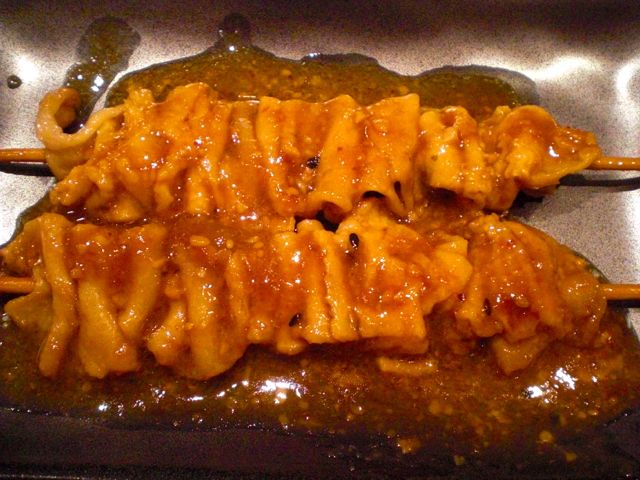
Another reason I made this was that I had 4 chicken thighs. I hand chopped the meat and made a portion of the chopped meat into a Japanese style chicken patty dish called tsukune (left upper in the image below). I made the other portion into chicken cutlets (both will be posted). Since I had the skin left over, rather than throwing it out, I decided to make it into this dish. It is a very lowly dish since chicken skin is almost free but requires some preparation. I first boiled the skins in water with a bit of sake for 10 minutes. I then washed them in cold running water. Using a sharp knife, I scraped off any stubbles of feathers and excess fat from the skin. I then cut the skin into a inch wide strips and skewered them as seen in the right upper of the image below).
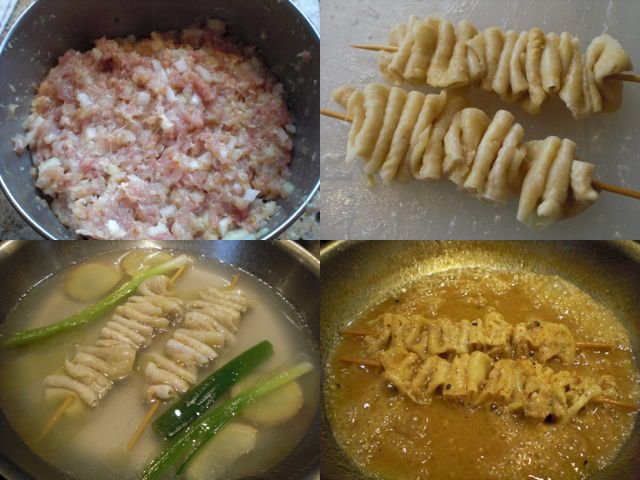
I put the skewers of chicken skin in a frying pan with fresh water and a splash of sake, slices of ginger and scallion as seen in the left lower of the iamge above and simmered it for 20 minutes or so with the lid on. I removed the scallion and ginger. At this point, the liquid is less than 1/4 cup. I disolved miso (1 tsp), sugar (1/2 tsp), sprinkled Japanese 7-flavored red pepper 七味唐辛子 and simmered for another 20 minutes (right lower in the image above) with the lid on. When the miso broth got thick I removed the skewers and lid and reduced it a bit further until it formed a thick sauce.
Monday, February 27, 2012
Baked green bean and carrot with tofu dressing インゲンと人参の白和え
This is another quick dish. When I made steamed tofu stuffed with shrimp and shiitake mushroom, I was left with 5-6 tea spoonfuls of tofu from the area I scooped out to make space for the shrimp stuffing. Using this extra portion of tofu, I made "shira-ae" dressing. "Shira-ae" 白和え means "white dressing". It is usually made with tofu, sesame, soy sauce and sugar, I made this with tofu, miso and mirin.

For the vegetable, I used baked green beans and carrots which my wife made over the weekend. She just coated the vegetables with olive oil, spreaded them out in a single layer on a cookie sheet seasoned with salt and baked in a 350F oven for 30 minutes. Baking vegetables makes them much sweeter than steaming or boiling them.
Shira-ae dressing: I just mixed tofu (5-6 tsp), miso (1 tsp), and mirin (few tsp or add until the consistency is just right).
It took only a few minutes to whip up this dish. If I used a pestle and mortar like a Japanese surikogi 擂り粉木 and suribachi すり鉢, the tofu dressing would have been smoother but I was too lazy at this point. This is healthy and nice dish.
Saturday, February 25, 2012
Steamed tofu stuffed with shrimp and shiitake 海老と椎茸の蒸し豆腐
I tried to make something special for Valentine's day but it was a weekday evening and we did not have much time after we came home. We popped open a bottle of Champagne (blanc de blanc 2004 vintage but I cannot remember which one this was. Very fruity with no yeasty note and we really liked it). After enjoying the Champagne with a snack of nuts, cheese and crackers, I decided to make this dish since I bought the silken tofu from a Japanese grocery store the previous weekend. This is a rather healthy and simple dish which will go well with any drink including Champagne.
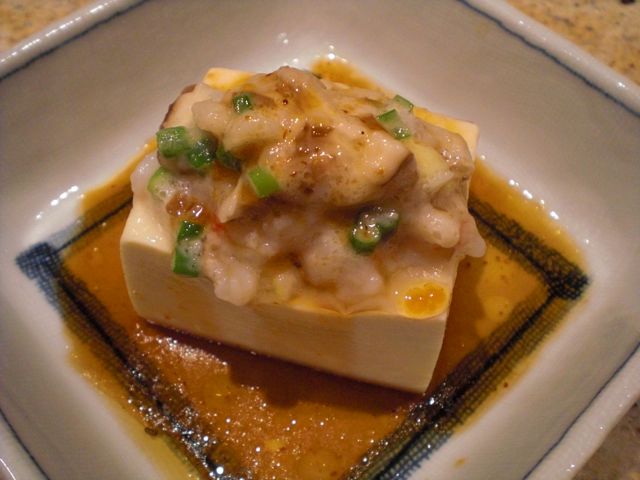
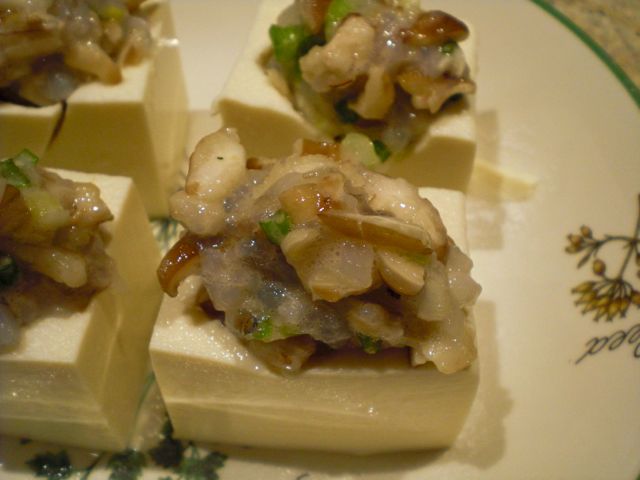
For sauce, I mixed ponzu shouyu (from the bottle), sesame oil (just a dash) and Japanese one-flavor red pepper or ichimi tougrashi 一味唐辛子 and poured it over the steamed stuffed tofu. This is a very gentle nice dish. The flavor of the mushrooms really came through with a pleasant earthiness permeating the tofu. The next day, I microwaved the 2 leftover cubes to warm them up. The dish tasted even better the second day. It also had a better texture for some reason.
The ingredients are; silken tofu (one cut into four), shrimp (6 medium sized frozen, thawed and shell removed and chopped into small pieces), fresh shiitake mushroom (1 large, thinly sliced and chopped) and scallion (one finely chopped).
I mixed all the ingredients in a bowl and added salt (1/4 tsp), egg white (one medium egg), potato starch (about 1 tsp) and mixed well.
I scooped out the center of the tofu cubes with a spoon, making craters just large and deep enough to accommodate stuffing without making a hole through the bottom of the cube. I then sprinkled a small amount of potato starch using a tea strainer on the craters I had just created in the tofu. This helps the stuffing adhere to the tofu.
I gently stuffed the crater and mounded up the shrimp mixture as you see in the picture below. I placed the dish with four squares of stuffed tofu in a steamer (I used an electric wok with continuous steam) for 15 to 20 minutes.
Thursday, February 23, 2012
Deep fried tofu pouch stuffed with chicken and bean sprouts 鶏笹身ともやしの巾着
We were having some very cold and windy days with a bit of snow (just a dusting with some wind-blown snow accumulation). We also had two small abura-age 油揚げ or deep fried tofu pouches left after making inarisuzhi いなり寿司. I decide to make a simplified version of Japanese winter stew or oden おでん. Please see more information in my previosu post for oden. Instead of the usual mochi-kin 餅巾 or mochi rice case in abura-age, I thought I would make pouches stuffed with pork, onion and bean sprouts. Especially since I had leftover blanched bean sprouts from making cellophane noodle salad. Whenever you stuff the abura-age pouch, the dish is caled "kinchaku" 巾着 which is the name for a traditional Japanese pouch. After I started the preparation, I realized I did not have any pork but I had two bone-in skin-on split chicken breasts which needed to be dispatched soon--before they went bad. I removed the breasts and two tenderloins. I made the breasts into microwave "sakamushi" 酒蒸し chicken. I made the stuffing for the tofu pouches from the chicken tenderloins adding shiitake and bean sprouts. The remaining breast bones were used to make the broth for the oden.
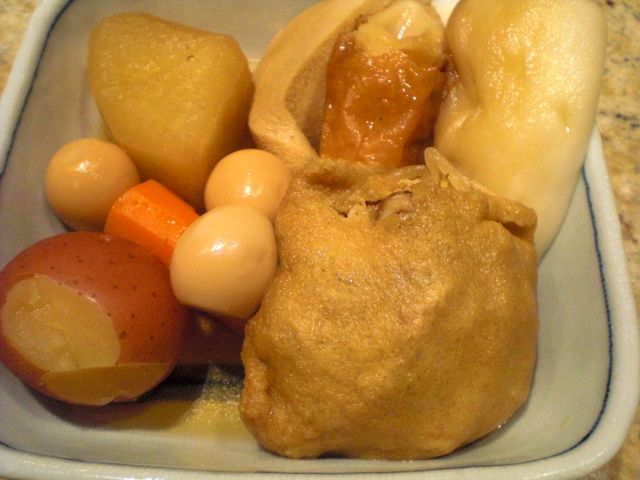
Revealing the content of the pouch.

Broth: I took a shortcut and used a dashi pack with dried fish, bonito flakes, kelp. I also added the bones from the chicken breasts as well (which was not the usual way of making broth for oden). In a pot, I added about 4 cups of water and a dashi pack. After simmering for 5 minutes, I added the chicken bones and simmered for another 20-30 minutes. I skimmed off any scum that appeared on the surface from the chicken bones. After I removed the bones and dashi pack, I strained the broth. I returned the broth to a donabe earthenware pot. I seasoned it with sake (3 tbp), mirin (3 tbs), soy sauce (2 tbs) and usukuchi 薄口 or light colored soy sauce (2 tbs). Later I adjusted the seasoning by adding a bit more light colored soy sauce.
Here is a serving of oden; the stuffed pouch is in the foreground accompanied by diakon, potato, carrot, quail eggs, freeze-dried tofu or shimi-dufu, chikuwa and hanpenn. I admit this does not look particularly photogenic.
Stuffed "kinchaku" pouch: The amounts of the ingredients are not accurate since I did not measure. I made just enough to stuff the two rectangular pouches seen below. I sautéed strips of chicken tenderloin (two), fresh mushrooms (5 small, cut into thin strips), blanched bean sprouts (one handful, probably 1/2 cup) in olive oil with a dash of sesame oil. I also added finely chopped ginger (1/8 tsp) and Japanese red pepper flakes. After few minutes of sautéing, I seasoned it with sake (2 tbs) and soy sauce (1 tbs). I braised it until the liquid was also most all gone.
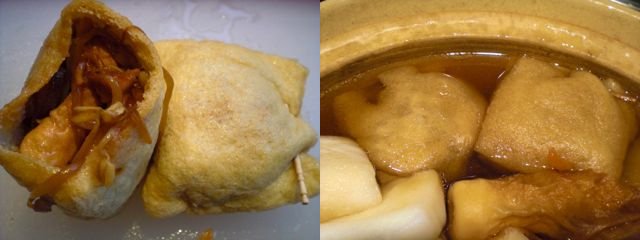
After the stuffing cooled enough to handle, I stuffed the pouches and closed them with a tooth pick (left on the image above). I simmered them in the oden broth with the other items (probably for about one hour. The broth should not boil or even simmer during this process).
Despite the change of plan the midway through, this was not too bad. Although I probably prefer my original intent of bean sprouts, onion, and ground pork, this kinchaku was not bad at all.
Despite the change of plan the midway through, this was not too bad. Although I probably prefer my original intent of bean sprouts, onion, and ground pork, this kinchaku was not bad at all.
Tuesday, February 21, 2012
Cellophane noodle, chicken skin and cucumber salad 春雨と雛皮の和え物
This was a small starter dish one evening. Again, I used what I had at hand to make this simple but tasty dish. The only item I cooked specifically for this dish was the cellophane noodle or "harusame" 春雨. This means "spring rain" which is a poetic name for Japanese-style cellophane noodles. Although this noodle is originally Chinese, the Japanese version is made from potatoes and corn starch (instead of mung bean startch). The other ingredient in the salad was the microwave "sakamushi" chicken which I made the day before. The blanched bean sprout was leftover from making the "kinchaku" oden dish.
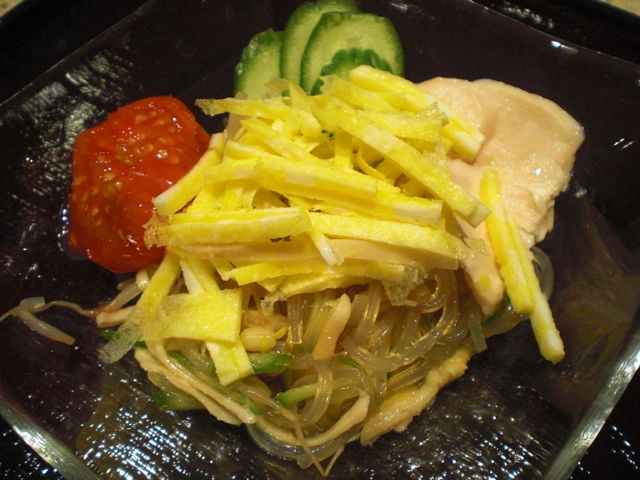
Noodle: On the left is a package of "harusame" noodle. It is dried and comes as brittle white straight noodles but once it is cooked, it becomes semi-transparent noodle with a unique texture--somewhat slippery, soft yet al dente. (The package touts "mochi mochi" mouthfeel). This noodle can be used in soup, nabe, or braised or stir-fried dish. The initial cooking needs to be adjusted depending on how you use it. In my case, I used it in a salad. So, I cooked it fully (about 7 minutes) in boiling water. I drained and washed the noodles immediately in cold running water. I cut the noodles into three segments for the ease of eating. The amount of noodle is totally arbitrary but I used 1/4 of the package. When cooked, the volume of the noodle increases about 4-5 fold.
Cucumber: I washed, salt-rubbed, washed again one American mini-cucumber and sliced it on a slant thinly first. I then julienned it. I salted, kneaded and squeezed out the excess moisture.
Bean sprout: Mung bean sprouts blanched which was leftover from making "kinchaku" oden item. I had about 1/2 cup.
Golden thread egg: This is an extra but I decided to make "kinshiran" 金糸卵. I used one egg beaten and seasoned with salt. I made a very thin omelet by cooking it on a very low flame using a non-stick frying pan coated with a small amount of vegetable oil and with the lid on. After it finished cooking, I cut it into 4 strips and then julienned.
This is a perfect small Izakaya dish to start. You could used chile oil instead of tabasco and sesame oil but this combination is one I always use in leu of chile oil. The combination of the noodle and bean sprout created very good textures and the chicken skin added favor. For instant dressing, the subtle heat from Tabasco and sesame flavor are excellent.
The amounts are all arbitrary but we had about 4 servings of the salad by the time I finished it (small servings as seen above).
Noodle: On the left is a package of "harusame" noodle. It is dried and comes as brittle white straight noodles but once it is cooked, it becomes semi-transparent noodle with a unique texture--somewhat slippery, soft yet al dente. (The package touts "mochi mochi" mouthfeel). This noodle can be used in soup, nabe, or braised or stir-fried dish. The initial cooking needs to be adjusted depending on how you use it. In my case, I used it in a salad. So, I cooked it fully (about 7 minutes) in boiling water. I drained and washed the noodles immediately in cold running water. I cut the noodles into three segments for the ease of eating. The amount of noodle is totally arbitrary but I used 1/4 of the package. When cooked, the volume of the noodle increases about 4-5 fold.
The sakamushi or sake-steamed chicken: I removed the skin of one breast and thinly sliced. I also sliced the meat (3 slices per serving).
Cucumber: I washed, salt-rubbed, washed again one American mini-cucumber and sliced it on a slant thinly first. I then julienned it. I salted, kneaded and squeezed out the excess moisture.
Bean sprout: Mung bean sprouts blanched which was leftover from making "kinchaku" oden item. I had about 1/2 cup.
Golden thread egg: This is an extra but I decided to make "kinshiran" 金糸卵. I used one egg beaten and seasoned with salt. I made a very thin omelet by cooking it on a very low flame using a non-stick frying pan coated with a small amount of vegetable oil and with the lid on. After it finished cooking, I cut it into 4 strips and then julienned.
Dressing: This is an instant dressing made of ponzu souyu ポン酢醤油 (from the bottle, about 3 tbs), dark sesame oil (about 1 tsp), and tabasco (to taste).
I dressed everything except for the golden thread egg. I put the cucumber and chicken slices in a shallow bowl and served the salad in the middle and garnished it with the golden thread egg.
This is a perfect small Izakaya dish to start. You could used chile oil instead of tabasco and sesame oil but this combination is one I always use in leu of chile oil. The combination of the noodle and bean sprout created very good textures and the chicken skin added favor. For instant dressing, the subtle heat from Tabasco and sesame flavor are excellent.
Sunday, February 19, 2012
Sushi in deep fried tofu pouch いなり寿司
When I made chirashi-zushi ちらし寿司, we had leftovers even after I packed lunch boxes for the next day. I made this quick inarizushi いなり寿司 on a subsequent weekday night. This is another type of sushi in which shushi rice is stuffed into deep fried tofu pouchs or abura-age 油揚げ. I posted why dishes using deep fried tofu or abura-age is called "Inari" as in this dish "inari-zushi" or "kitsune" as in "kitsune-soba" きつねそば before. To briefly reiterate, it was said that messengers of the Diety enshrined in Inari-jinja 稲荷神社 are a pair of foxes or kitstune 狐 and somehow it was believed that deep fried tofu was their favorite food.
 The above picture is just to show this was stuffed with seasoned chirashizushi with hijiki, shiitake mushroom, gobou and carrot. Although we sometimes bought inarizushi from the Japanese grocery store, I seldom made it.
The above picture is just to show this was stuffed with seasoned chirashizushi with hijiki, shiitake mushroom, gobou and carrot. Although we sometimes bought inarizushi from the Japanese grocery store, I seldom made it.
In any case, I defrosted 4 small rectangular abura-age called "Inari-age" 稲荷揚げ by pouring hot water over them in a colander. This will defrosts them as well as washes away some of the oiliness which is called "abura-nuki" 油抜き. I pressed the pieces between the paper towels to remove the moisture.
I placed these in a small sauce pan and added water (100ml), mirin (2 tbs) and soy sauce (1 tbs) and simmered for 10-15 minutes turning the inari-age several times until the seasoning liquid was almost all gone. I let it cool down and again pressed the pieces between paper towels to remove the excess moisture. I then cut one end off the pouch and opened it up. Just for decorative purposes, I turned one of the halves in-side-out (left one in the image below)
 You could stuff the pouch with plain sushi rice. This time, I had left over flavored sushi, I microwave it and added a bit more sushi vinegar and let it cool down to room temperature and stuffed the seasoned tofu pouches. You could buy pre-seasoned tofu pouches in a Japanese grocery store (I think they are frozen) but I never used them myself. I served it with my cucumber, diakon and carrot asazuke 浅漬け and "gari" ginger.
You could stuff the pouch with plain sushi rice. This time, I had left over flavored sushi, I microwave it and added a bit more sushi vinegar and let it cool down to room temperature and stuffed the seasoned tofu pouches. You could buy pre-seasoned tofu pouches in a Japanese grocery store (I think they are frozen) but I never used them myself. I served it with my cucumber, diakon and carrot asazuke 浅漬け and "gari" ginger.
My wife thouhgt this was great. Stuffing it with seasoned chirashizushi made this dish much more savory than the simple white sushi rice version. She even thought the two tasted different but, as I mentioned, the only difference was that one pouch had been turned inside out. Even after making the inarizushi, we still had some flavored sushi rice left.
Friday, February 17, 2012
Natto, avocado and tofu on Belgian endive チコリの納豆、豆腐とアボカドの乗せ
Sometimes, what we have dictates what I can make. I bought 4 avocados last weekend but all of them were now quite ripe. If I missed this moment of avocado perfection, they would become mushy, start developing blemishes in a hurry and guacamole would be inevitable. Of course, just nanoseconds before this moment, they were rock hard. In fact, two of them had passed into guacamole land. Another graced a sandwich for the next day's lunch. I made this dish from the last avocado. I came up with this dish since I happened to have a small container of Otokomae tofu and frozen natto in the freezer. In addition, my wife, after many years of abstention, has now come around to eating natto.
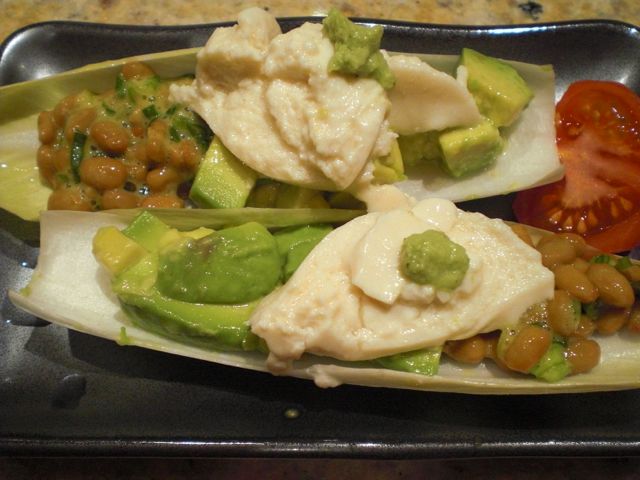 This is a simple spur-of-the-moment quick dish. Did I tell you I also had Belgian endive? (which is called "Chikori" or chicory in Japan. Chicory in the U.S. usually means a root of this plant which is used as a coffee substitute or additives).
This is a simple spur-of-the-moment quick dish. Did I tell you I also had Belgian endive? (which is called "Chikori" or chicory in Japan. Chicory in the U.S. usually means a root of this plant which is used as a coffee substitute or additives).
In any case, this is not a recipe. I just prepared nattou as usual using the seasoning liquid and mustard packets that came with the natto. I just added chopped scallion and mixed it using my nattou mixing contraption well. I removed the stone, skin and cubed the avocado and dressed it with lemon juice and placed the pieces on the endive leaves. I added a few small scoops of soft otokomae tofu and placed a dab of real wasabi on top. Just before eating, we sprinkled on soy sauce and mixed with a small spoon. We ate this with our fingers; picking up the endive leaves. (A word of advice: Start eating from the soft tip of the leaves, otherwise, the leaves will not hold the contents. You do not want to spill nattou on your shirt).
This is not bad at all. The combination of avocado, silken tofu, and nattou is remarkably good. With nattou, sake is the recommended libation.
Subscribe to:
Posts (Atom)

